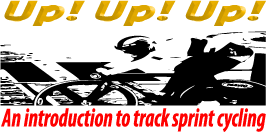Divide and conquer
One useful way to look at a flying 200 to train for it and ride it effectively, is to break it down into components and see how it all fits together.
We'll do this first by example.
Say you have a desire to ride a 10.0s flying 200. That's an average speed over the timed distance of 72km/h. For most sprinters, this means a peak speed as you exit turn two, of around 75-77km/h and a finishing speed of around 68-70km/h. There are some who will have less peak and less drop off in the last 100m, but most sprinters will ride roughly this speed profile. We typically see a peak around 5-8% faster than the average speed needed.
In order to hit that peak speed, you will need to accelerate using the banking of the track from a speed of somewhere between 50 and 55km/h (elite male) assuming that in the around 170m from your most likely jump point of mid bend turn 3/4 you can gain from 18-25km/h.
So the windup needs to deliver you to your jump point at the speed which you can then accelerate to your peak speed, with the help of the downhill from the banking, by the exit to turn 2, with minimal fatigue. This is where it is very useful to have a speedo on your bike in training - you want to arrive at your jump point at the target speed. Practice this. Lots. We have a drill called a "roll entry" where you ride the windup only, at the jump point you do two hard pedal strokes, then sit down and roll the flying 200 line. Make it part of your warmup.
We haven't mentioned cadence or gear choice yet. The best way to work this out is to know what cadence you can get up to and produce useful power. For most humans, this is somewhere between 130 and 145rpm. Some very rare individuals can produce useful power at higher cadences, but these are very rare people indeed.
So if you're a 140rpm guy, and your peak speed target is 77km/h, you're going to want around a 114-115 inch gear. See the Big Gear Chart for a handy reference here. If you then look back and see 77km/h minus ~20km/h is about 55-57km/h, that's a jump point cadence of around 105 rpm. Nice, right in the sweet spot for delivering peak power.
You're going to want to train that acceleration - work on 170m accelerations from around 90-100 rpm to 140 or so (spanning the range by a little more, so you have some extra that you've trained) in a range of gears working up to the biggest gear that you can still hit the target cadence on. See our "Target Cadence" method for how to do this effectively.
You'll also want to be able to wind up with minimal fatigue and accuracy - see the roll entries above.
Finally, you will need to be able to keep going - fatigue is cadence-dependent - practice doing 200m at the peak cadence - you can do this solo, behind a motorbike etc, imagination is your limiter for how to do this.
Have fun, go faster.
